Metalcore
Metalcore (also known as metallic hardcore)[6] is a fusion music genre that combines elements of extreme metal and hardcore punk. As with other styles blending metal and hardcore, such as crust punk and grindcore, metalcore is noted for its use of breakdowns, slow, intense passages conducive to moshing. Other defining instrumental qualities include heavy riffs and stop-start rhythm guitar playing,[7] occasional blast beats, and double bass drumming. Vocalists in the genre typically use thrash or scream vocals. Some later metalcore bands combine this with clean singing, often during the chorus. Death growls and gang vocals are common. 1990s metalcore bands were inspired by hardcore while later metalcore bands were inspired by melodic death metal bands like At the Gates and In Flames.
| Metalcore | |
|---|---|
| Other names | Metallic hardcore |
| Stylistic origins |
|
| Cultural origins | Early–mid 1990s, United States |
| Derivative forms | |
| Subgenres | |
| Mathcore | |
| Fusion genres | |
| |
| Regional scenes | |
| South East England | |
| Local scenes | |
| |
The roots of metalcore are in the 1980s when bands would combine hardcore punk with heavy metal. This included New York hardcore bands like Agnostic Front, Cro-Mags, and Killing Time, British hardcore punk bands like the Exploited and Discharge, and American crossover thrash bands like Dirty Rotten Imbeciles and Suicidal Tendencies. The genre emerged in the early 1990s and expanded in the mid–late 1990s. Metalcore bands like Integrity, Earth Crisis, Hatebreed, Converge, Shai Hulud, Vision of Disorder, Merauder, and Disembodied emerged and acquired underground success in the 1990s.
In the mid-2000s, metalcore became one of the most popular heavy metal subgenres with the success of bands like Bleeding Through, Avenged Sevenfold, Killswitch Engage, Hatebreed, Atreyu, Shadows Fall, As I Lay Dying, Unearth, Trivium, Bullet for My Valentine, and All That Remains. Metalcore's popularity continued in the 2010s with the success of bands like Asking Alexandria, August Burns Red, and the Devil Wears Prada. Metalcore subgenres like deathcore, easycore and electronicore also emerged in the 2000s decade. Other subgenres of metalcore include mathcore, nu metalcore, melodic metalcore and progressive metalcore.
Characteristics

Metalcore is known for its use of breakdowns, in which it was preceded by beatdown hardcore.[8] Metalcore singers typically perform screaming,[9] a vocal technique developed in the 1980s and characteristic of 1990s metalcore. Later metalcore bands often combine this with the use of standard singing, usually during the bridge or chorus of a song.[9] The death growl technique is also popular.
The instrumentation of metalcore includes heavy guitar riffs often utilizing percussive pedal tones, stop-start rhythm guitar,[7] double bass drumming, and breakdowns.[9] Drop guitar tunings are often used. Most bands use tuning ranging between Drop D and A, although lower tunings, as well as 7 and 8 string guitars, are not uncommon. Drummers typically use a lot of double bass technique and general drumming styles across the board. Blast beats are also heard at times. According to author James Giordano, "tempos in metalcore tend to be slower than those found in thrash metal".[10] Many later metalcore bands would include guitar solos in songs.
1990s metalcore bands generally had a strong influence from heavy hardcore. In the 2000s, metalcore bands began to be exclusively inspired by heavy metal.[9] Many 2000s metalcore bands were heavily inspired by melodic death metal and used strong elements of melodic death metal in their music.[11] Malcolm Dome of Revolver wrote that without melodic death metal band At the Gates' 1995 album Slaughter of the Soul, "modern American metalcore (everyone from As I Lay Dying and Killswitch Engage to All That Remains and the Black Dahlia Murder) wouldn't even exist."[12] Graham Hartmann of Loudwire wrote "Although metalcore broke in the early 2000s, listening to At the Gates' 1995 album feels like a Nostradamus-esque prediction of how metal would evolve."[13]
History
Precursors (1980s)
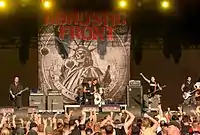
Black Flag[14] and Bad Brains,[15] among the originators of hardcore punk, admired and emulated Black Sabbath. British hardcore punk groups such as Discharge and the Exploited also took inspiration from heavy metal.[16] The Misfits put out the Earth A.D. album, becoming a crucial influence on thrash metal.[17] Nonetheless, punk and metal cultures and music remained fairly separate through the first half of the 1980s. Cross-pollination between metal and hardcore eventually birthed the crossover thrash scene, which gestated at a Berkeley club called Ruthie's, in 1984.[18] The term "metalcore" was originally used to refer to these crossover groups.[19] Hardcore punk groups Corrosion of Conformity,[20] D.R.I. and Suicidal Tendencies[21] played alongside thrash metal groups like Metallica and Slayer. This scene influenced the skinhead wing of New York hardcore, which also began in 1984, and included groups such as Cro-Mags, Murphy's Law, Agnostic Front[22] and Warzone.[23] The Cro-Mags were among the most influential of these bands, drawing equally from Bad Brains, Motörhead and Black Sabbath.[24] Cro-Mags also embraced some aspects of straight edge and Krishna consciousness.[25] Another New York metal-influenced straight edge group of this time period is the Crumbsuckers. The year 1985 saw the development of the hardcore breakdown, an amalgamation of Bad Brains' reggae and metal backgrounds,[26] which encouraged moshing. Agnostic Front's 1986 album Cause for Alarm showed a combination of hardcore punk with heavy metal influences.[27]

Origins (1990s)
Between 1993 and 1995, a wave of metallic hardcore bands emerged,[28] including Integrity,[29] Earth Crisis,[29][30] Converge,[30] Focal Point, Strongarm, Shai Hulud,[31][32][33] Judge,[30] Strife,[29] Rorschach,[34] Vision of Disorder[34] Hatebreed,[29][34] Zao,[35] and Disembodied.[36]

Integrity drew influence from the hardcore band G.I.S.M. and the thrash metal band Slayer, with others like Septic Death, Samhain, Motörhead and Joy Division. Earth Crisis and Hatebreed[37] borrowed from hardcore punk and took influence from death metal.[38] Earth Crisis's albums Firestorm, Destroy the Machines and Gomorrah's Season Ends were early examples of metalcore,[39][40][41] as was Vision of Disorder's self-titled full-length debut in 1996.[42] Coalesce and Overcast were also important early metalcore groups.[43] Journalist Lars Gotrich wrote, "Along with key records by The Dillinger Escape Plan and Botch, Give Them Rope (1997) is an underground milestone that helped [further] what was soon [universally] called 'metalcore'. At the risk of sounding too reductive—metalcore was the natural progression where extreme metal and hardcore met, but with spiraling time signatures that somehow felt more aggressive."[44] Shai Hulud's 1997 album Hearts Once Nourished with Hope and Compassion became especially influential in the latter part of the decade.[31][32][33] Hatebreed released their debut album Satisfaction is the Death of Desire in 1997. The album helped the band achieve underground success, selling 158,000 copies, according to Nielsen SoundScan.[45]
Success (2000s)
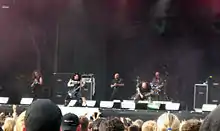
In the early 2000s, metalcore started to gain more prominence, with several independent metal labels, including Century Media and Metal Blade, signing metalcore bands. Hatebreed released their second album Perseverance in 2002. The album sold 234,000 copies in the United States.[45] Hatebreed's 2003 album The Rise of Brutality and 2006 album Supremacy peaked at numbers 30 and 31 on the Billboard 200, respectively.[46] A new subgenre, melodic metalcore, strongly influenced by Swedish melodic death metal, has formed and quickly came to the forefront of metalcore's rise to popularity. In 2002, Killswitch Engage's Alive or Just Breathing reached number 37 on the Heatseekers Albums chart.[47] In 2004, Killswitch Engage's The End of Heartache,[48] Shadows Fall's The War Within,[49][50] and Atreyu's The Curse[51] peaked at numbers 21, 20, and 36 on the Billboard 200, respectively. Also, in 2006, Atreyu's third studio album, A Death-Grip On Yesterday peaked at number 9 on the Billboard 200, only to be followed up by 2007's Lead Sails Paper Anchor, which peaked at number 8.[51] Atreyu's 2002 debut album Suicide Notes and Butterfly Kisses, as of July 3, 2004, has sold 107,000 copies in the United States.[52] Killswitch Engage's 2004 album The End of Heartache[53] and 2006 album As Daylight Dies[54] were both certified gold by the Recording Industry Association of America (RIAA) in 2007 and 2009, respectively. Killswitch Engage's 2002 album Alive or Just Breathing, as of July 3, 2004, has sold 114,000 copies in the United States.[52] Unearth began to have success among heavy metal fans in 2004 with the release of their second album The Oncoming Storm, which peaked at number 1 on the Heatseekers Albums chart on July 17, 2004.[55] On that same day, the album peaked at number 105 on the Billboard 200. Unearth's 2006 album III: In the Eyes of Fire peaked at number 35 on the Billboard 200. The band's 2008 album The March peaked at number 45 on the Billboard 200.[56] Oncoming Storm, III: In the Eyes of Fire', and The March peaked at numbers 6, 2 and 3 on the Independent Albums chart, respectively.[57] Avenged Sevenfold's first two albums Sounding the Seventh Trumpet (2001) and Waking the Fallen (2003) were both metalcore albums. On the band's 2005 album City of Evil, Avenged Sevenfold moved away from metalcore and changed to a traditional heavy metal sound.[58] On June 15, 2005, Blabbermouth.net reported that Waking the Fallen has sold 172,253 copies in the United States, according to Nielsen SoundScan.[59] On July 17, 2009, Waking the Fallen was certified gold by the RIAA.[60]

Metalcore band As I Lay Dying also achieved success among heavy metal fans. The band's 2005 album Shadows Are Security peaked at number 35 on the Billboard 200[61] and sold 263,000 copies, according to Nielsen SoundScan.[62] As I Lay Dying's 2007 album An Ocean Between Us peaked at number 8 on the Billboard 200 in 2007.[61] As of April 2005, As I Lay Dying's 2003 album Frail Words Collapse sold 118,000 copies in the United States.[63] All That Remains achieved success with their 2006 album The Fall of Ideals, which, as of October 1, 2008, sold 175,000 copies in the United States.[64] All That Remains' 2008 album Overcome peaked at number 16 on the Billboard 200.[64] Overcome's song "Two Weeks" peaked at number 9 on the Mainstream Rock Songs chart on May 16, 2009.[65] Bullet for My Valentine's debut album The Poison was released in October 2005 in Europe and was released in February 2006 in the United States. On July 26, 2006, Blabbermouth.net reported that The Poison has sold 72,000 copies in the United States.[66] On October 27, 2007, Blabbermouth.net reported that The Poison has sold 336,000 copies in the United States.[67] On April 3, 2010, Billboard reported that The Poison sold 573,000 copies in the United States.[68] The Poison was certified gold by the RIAA on January 30, 2009.[69] Bullet for My Valentine's second album Scream Aim Fire, released in 2008, peaked at number 4 on the Billboard 200 and sold 360,000 copies in the United States.[68] Bullet for My Valentine's 2010 album Fever peaked at number 3 on the Billboard 200, selling 71,000 copies in the United States during its first week of release.[68] Fever's song "Your Betrayal" peaked at number 25 on the Bubbling Under Hot 100 chart.[70] Trivium also achieved success among heavy metal fans when their 2005 album Ascendancy peaked at number 151 on the Billboard 200. Their albums The Crusade (2006) and Shogun (2008) peaked at numbers 25 and 23 on the Billboard 200, respectively.[71] Bleeding Through's 2006 album The Truth peaked at number 1 on the Independent Albums chart on January 28, 2006.[72] On that same day, the album peaked at number 48 on the Billboard 200.[73]
Rise of deathcore (mid–late 2000s)
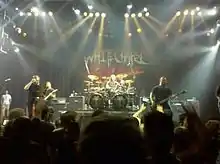
In 2006 and 2007 a wave of metalcore bands strongly influenced by death metal dubbed deathcore gained moderate popularity. Notable bands that brought the genre to the fore include Bring Me the Horizon and Suicide Silence. Suicide Silence's No Time to Bleed peaked at number 32 on the Billboard 200, number 12 on the Rock Albums Chart and number 6 on the Hard Rock Albums Chart,[74] while their album The Black Crown peaked at number 28 on the Billboard 200, number 7 on the Rock Albums Chart and number 3 on the Hard Rock Albums Chart.[74] After its release, Whitechapel's album This Is Exile sold 5,900 in copies, which made it enter the Billboard 200 chart at position 118.[75] Their self-titled album peaked at number 65 on the Canadian Albums Chart[76] and also at number 47 on the Billboard 200.[77] Their third album A New Era of Corruption sold about 10,600 copies in the United States in its first week of being released and peaked at position number 43 on the Billboard 200 chart.[78] Furthermore, Bring Me the Horizon won the 2006 Kerrang! Awards for Best British Newcomer after they released their 2006 debut record Count Your Blessings.[79] However, Bring Me the Horizon abandoned the deathcore genre after the release of this album.[80] San Diego natives Carnifex, witnessed success with their first album Dead in My Arms, selling 5,000 copies with little publicity. On top of their non-stop touring and methodical songwriting resulted in Carnifex quickly getting signed to label Victory Records.[81] Lastly, Australian deathcore band Thy Art Is Murder debuted at number 35 on the ARIA Charts with their album Hate (2012)[82] making them the first extreme metal band to ever reach the Top 40 of this chart.[83]
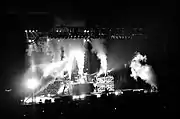
Continued success (2010s–present)
By the early 2010s, metalcore was evolving to more frequently incorporate synthesizers and elements from genres beyond rock and metal. Many other metalcore bands emerged and achieved a lot of success. The Devil Wears Prada's 2011 album Dead Throne (which sold 32,400 in its first week)[84] reached number 10[85] on the Billboard 200 chart. Asking Alexandria also achieved success, with their 2009 signature song "Final Episode (Let's Change the Channel)" being certified gold by the RIAA.[86] The band's 2011 album Reckless & Relentless peaked at number 9 on the Billboard 200.[87] Other metalcore bands achieving success in the early and mid-2010s include Motionless in White, Blessthefall, The Amity Affliction, and August Burns Red.
In 2018, an article in Kerrang! referred to a revival of an earlier style of metalcore, described as "a dark, powerful combination of hardcore’s honest fury and thrash’s cutthroat riffage", citing Vein, Vatican, Thirty Nights of Violence, and Chamber as the frontrunners of the style.[88] The Odyssey also referred to Code Orange, Knocked Loose, Varials, Jesus Piece, Counterparts, Employed to Serve and Kublai Khan as groups gaining significant success within the genre.[89] Knocked Loose released their 2019 sophomore effort A Different Shade of Blue to critical and commercial success.[90][91] Code Orange also saw critical acclaim and success with their Roadrunner Records debut Forever in 2017. Forever's title track was also nominated Grammy for Best Metal Performance in 2018.[92][93][94][95]
In the early-2020s, a number of bands gained prominence in the scene that revived the sound of groups from the mid-to-late-2000s, fronted by Static Dress, SeeYouSpaceCowboy, If I Die First and CrazyEightyEight. This movement grew out of both the hardcore scene and the mainstream success that the emo rap scene gained the late-2010s.[96]
Subgenres
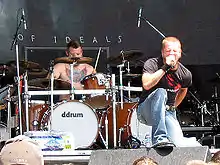
Melodic metalcore
The early 2000s included a wave of metalcore bands who placed significantly greater emphasis on melody. Melodic metalcore bands include Killswitch Engage, Avenged Sevenfold, As I Lay Dying, Trivium, Dead by April,[97] All That Remains,[98] Atreyu,[99][100] Bullet for My Valentine,[101] Bury Tomorrow,[102] Darkest Hour,[99] Shadows Fall, and August Burns Red.[103][104][105] These groups took major influence, cues, and writing styles from Swedish melodic death metal bands, particularly At the Gates,[99] In Flames, Arch Enemy and Soilwork.[106] Melodic metalcore often employs clean vocals.[107][108]
Mathcore
Mathcore began with the mid-1990s work of Converge,[109] Botch[110][111] Eso-Charis,[112] Since the Fall, Coalesce,Training For Utopia, and The Dillinger Escape Plan.[113] The term mathcore is meant to suggest an analogy with math rock. Mathcore is characterized by increased speed, technical riffing, and unusual time signatures.[114][115] Bands such as Fear Before also combine the metalcore sound with odd time signatures, as well as progressive elements.[116]
Deathcore
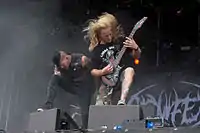
Deathcore is a fusion of metalcore and death metal.[117][118][119] Deathcore is defined by breakdowns, blast beats and death metal riffs.[120][121] Bands may also incorporate guitar solos and even riffs that are influenced by metalcore.[117] New York-based death metal group Suffocation is credited as one of the main influences for the emergence of deathcore. Embodyments album "Embrace The Eternal" is a foundation for the modern Deathcore sound.[122] Some examples of deathcore bands are Suicide Silence,[123] Whitechapel,[123] Knights of the Abyss,[124] Carnifex,[123] Chelsea Grin[125] and Impending Doom.[126]
Electronicore
Electronicore describes a stylistic fusion of electronic music and metalcore.[127]
Progressive metalcore
Progressive metalcore is a fusion of progressive metal and metalcore characterized by highly technical lead guitar and djent-influenced breakdowns.[128][129][130][131] Practitioners of the genre often rely heavily on "atmospheric" elements and complex instrumentation.[131][132]
Nu metalcore
Nu metalcore is the musical fusion of nu metal and metalcore originating in the 2010s.[133] Many notable groups take influence from deathcore, R&B,[133] post-hardcore[134] and industrial metal.[135] Metalcore and deathcore groups[136] such as Emmure,[137][138][139] Of Mice & Men,[140][141][142] Suicide Silence (The Black Crown album),[143][144] and Issues[145][146] all gained moderate popularity drawing influence from nu metal and metalcore.
See also
- List of metalcore bands
References
- "Resistance" (22–26). Resistance Records. 2004: 111.
{{cite journal}}: Cite journal requires|journal=(help) - ROA, RAY. "WTF is sasscore, and why is SeeYouSpaceCowboy bringing it to St. Petersburg's Lucky You Tattoo?". Creative Loafing. Retrieved 9 February 2019.
- Chaudhury, Aliya (14 April 2021). "Why hyperpop owes its existence to heavy metal". Kerrang!. Retrieved August 14, 2021.
- "Horse the Band, Super 8 Bit Brothers, Endless Hallway, and Oceana | Music | Events | the A.V. Club Chicago". www.avclub.com. Archived from the original on 15 March 2012. Retrieved 17 January 2022.
- "New 8-bit metalcore album revives nintendocore with brutal N64 theme—listen". Alternative Press. 17 July 2016.
- Bennett, J (June 2008). "Converge's "Jane Doe"". Revolver.
- "Wristmeetrazor Channel Vintage Metalcore Energy on Misery Never Forgets". MetalSucks. January 9, 2019. Retrieved December 8, 2020.
- "Resistance" (22–26). Resistance Records. 2004: 111.
{{cite journal}}: Cite journal requires|journal=(help) - Bowar, Chad. "What Is Metalcore?". liveabout.com. Retrieved November 16, 2014.
- Giordano 2016, p. 141.
- Crane, Matt (September 2, 2014). "12 melodic death-metal songs any self-respecting metalcore fan should like". Alternative Press. Retrieved November 30, 2019.
- Dome, Malcolm (November 14, 2018). "How At the Gates Changed Metal Forever With 'Slaughter of the Soul'". Revolver. Retrieved November 30, 2019.
- Hartmann, Graham (January 21, 2014). "Will At the Gates Release a New Album in 2014?". Loudwire. Retrieved November 30, 2019.
- Blush, American Hardcore, part 2, "Thirsty and Miserable", p. 63, 66.
- Andersen, Mark and Mark Jenkins (2003). Dance of Days: Two Decades of Punk in the Nation's Capital. "Positive Mental Attitude". p. 27. Akashic Books. ISBN 1-888451-44-0.
- Glasper, Ian (2004). Burning Britain: The History of UK Punk 1980–1984. Cherry Red Books. p. 5. ISBN 1-901447-24-3.
- Blush, "Hits from Hell", American Hardcore, p. 204.
- Blush, p. 115.
- Felix von Havoc, Maximum Rock'n'Roll #198 Archived June 5, 2008, at the Wayback Machine. Access date: June 20, 2008.
- Blush, p. 193.
- Christe, Ian: Sound of the Beast: The Complete Headbanging History of Heavy Metal (2003), p. 184.
- Blush, p. 186.
- Blush, p. 188.
- Blush, p. 189.
- Blush, p. 189. "Cro-Mags were the first band to attract both Skinheads and Metalheads audiences; their music at the point where Hardcore nihilism met Metal power."
- Blush, p. 193. "Howie Abrams (NYHC scene): Mosh style was slower, very tribal – like a Reggae beat adapted to Hardcore. (...) It was an outbreak of dancing with a mid-tempo beat driven by floor tom and snare."
- Blush, p. 192.
- "Blood Runs Deep: 23 Bands Who Shaped Punk". Alternative Press. July 7, 2008. pp. 110, 118. Archived from the original on August 2, 2017. Retrieved June 12, 2017.
- Ian Glasper, Terrorizer no. 171, June 2008, p. 78, "here the term (metalcore) is used in its original context, referencing the likes of Strife, Earth Crisis, and Integrity (...)".
- Mudrian, Albert (2000). Choosing Death: The Improbable History of Death Metal and Grindcore. Feral House. ISBN 1-932595-04-X. p. 222-223.
- "Kill Your Stereo – Reviews: Shai Hulud – Misanthropy Pure".
Shai Hulud, a name that is synonymous (in heavy music circles at least) with intelligent, provocative and most importantly unique metallic hardcore. The band's earliest release is widely credited with influencing an entire generation of musicians
. - "Shai Hulud – Hearts Once Nourished with Hope and Compassion Review". Sputnikmusic. Retrieved July 11, 2012.
Hearts Once Nourished with Hope and Compassion is pretty much the prime in early melodic metalcore. So many bands in both the modern metalcore and hardcore scene have drawn vast influence from them, because of how perfect they blend hardcore and metal.
- "In at the Deep End Records".
Regardless of whether or not you liked Shai Hulud, it is undeniable that Hearts Once Nourished with Hope and Compassion was an oft-imitated and highly influential release in the mid-to-late nineties.
- Ross Haenfler, Straight Edge: Clean-living Youth, Hardcore Punk, and Social Change. Rutgers University Press. ISBN 0-8135-3852-1. p. 87-88.
- "Metal Hammer – The Top 10 best proto-metalcore records". 22 July 2020.
Zao is one of the best examples of early metalcore, and their influence on the genre is undeniable. The guitar work, the high throaty style of the vocals, and the band aesthetics are all pieces that would have great influence on bands down the road.
. - Sharpe-Young, p. 119
- Hatebreed cites Entombed and Bolt Thrower. Q&A with Jamey Jasta, Miami New Times, May 27, 2008 Archived September 20, 2011, at the Wayback Machine. Access date: June 22, 2008.
- Karl Buechner of Earth Crisis cites Napalm Death, Bolt Thrower, and Obituary as prime influences. Mudrian also discusses Converge and Bloodlet and their relationship to death metal. See Mudrian, Albert (2000). Choosing Death: The Improbable History of Death Metal and Grindcore. Feral House. ISBN 1-932595-04-X. p. 222-223.
- Gabriel Cardenas Salas, "Blasts from the Past", Terrorizer 180, February 2009, p. 96.
- Deneau, Max (April 15, 2009). "Scott Crouse of Earth Crisis". Exclaim!. Archived from the original on July 4, 2017. Retrieved October 15, 2017.
Earth Crisis started it all, pretty much. Opening the door for countless metal/hardcore hybrids and setting the bar for politically motivated heavy music, Earth Crisis trailblazed their way through the '90s with a series of landmark releases, particularly the Firestorm EP and Destroy the Machines.
- Ernst, Tobias (June–July 2007). "EARTH CRISIS | ZURÜCK ZU DEN WURZELN" [EARTH CRISIS | BACK TO THE ROOTS]. Ox-Fanzine (in German). No. 72. Archived from the original on June 20, 2009. Retrieved October 15, 2017.
EARTH CRISIS waren Mitte der 1990er Jahre nicht nur eine der vehementesten Vertreter des Veganismus und der Straight Edge-Bewegung, sondern auch musikalisch auf dem Höhepunkt ihrer Karriere. Mit ihrem Album "Gomorrah's Season Ends" bereiteten sie den Weg für einen Musikstil, der heute allgemein als Metalcore bezeichnet wird, und waren zusammen mit INTEGRITY ein maßgeblicher Einfluss für unzählige Metalcore-Bands der letzten Jahre. (In the mid-1990s, EARTH CRISIS was not only one of the most vehement representatives of veganism and the straight-edge movement, but also were musically at the peak of their career. With their album Gomorrah's Season Ends they paved the way for a musical style that is now generally known as Metalcore, and together with INTEGRITY they have been a major influence for countless metalcore bands of recent years.)
- "Album Reviews: Vision of Disorder - The Cursed Remain Cursed". Teufel's Tomb. Retrieved April 14, 2013.
- J. Bennett, "Converge's Jane Doe", Revolver, June 2008.
- Lars Gotrich, "Coalesce: A Tale of Two Ropes" Archived 2015-04-20 at the Wayback Machine, All Songs Considered, 25 October 2011.
- Reesman, Bryan (April 3, 2004). "Victory Scores With Indie Grit". Billboard. Vol. 116, no. 14. Nielsen Business Media, Inc. p. 22. ISSN 0006-2510. Retrieved November 29, 2019.
- "Hatebreed Chart History". Billboard. Retrieved November 29, 2019.
- "Killswitch Engage Chart History (Heatseekers Albums)". Billboard. Retrieved November 29, 2019.
- "Killswitch Engage Chart History (Billboard 200)". Billboard. Retrieved November 29, 2019.
- "Shadows Fall to Co-Headline Sounds of the Underground". Blabbermouth.net. Archived from the original on August 19, 2011. Retrieved July 11, 2012.
- "Shadows Fall (Chart History)". Billboard. Retrieved November 29, 2019.
- "Atreyu Chart History". Billboard. Retrieved November 29, 2019.
- Christman, Ed (July 3, 2004). "Atreyu Gets Victory Plan". Billboard. Vol. 116, no. 27. Nielsen Business Media, Inc. p. 41. ISSN 0006-2510. Archived from the original on February 20, 2021. Retrieved November 29, 2019.
- "American album certifications – Killswitch Engage – The End of Heartache". Recording Industry Association of America.
- "American album certifications – Killswitch Engage – As Daylight Dies". Recording Industry Association of America.
- "Unearth Chart History (Heatseekers Albums)". Billboard. Retrieved November 29, 2019.
- "Unearth Chart History (Billboard 200)". Billboard. Retrieved November 29, 2019.
- "Unearth Chart History (Independent Albums)". Billboard. Retrieved November 29, 2019.
- Weiderhorn, Joe (June 9, 2005). "Avenged Sevenfold Salute Dimebag, Shun Metalcore On Evil". MTV. Retrieved November 29, 2019.
- "Avenged Sevenfold's 'City Of Evil' Enters Billboard Chart At No. 30". Blabbermouth.net. June 15, 2005. Archived from the original on September 20, 2020. Retrieved November 29, 2019.
- "American album certifications – Avenged Sevenfold – Waking the Fallen". Recording Industry Association of America.
- "As I Lay Dying". Billboard. Retrieved November 29, 2019.
- Titus, Christa (July 28, 2007). "As I Stay Touring". Billboard. Vol. 119, no. 30. Nielsen Business Media, Inc. p. 46. ISSN 0006-2510. Archived from the original on February 20, 2021. Retrieved November 29, 2019.
- "AS I LAY DYING: New Album Limited Edition To Include Bonus DVD". Blabbermouth.net. April 28, 2005. Archived from the original on December 3, 2020. Retrieved November 29, 2019.
- "ALL THAT REMAINS: Behind-The-Scenes Footage From 'Two Weeks' Video Shoot Available". Blabbermouth.net. October 1, 2008. Retrieved November 29, 2019.
- "All That Remains Chart History (Mainstream Rock Songs)". Billboard. Retrieved November 29, 2019.
- "BULLET FOR MY VALENTINE: 'The Poison' Reissue Detailed". Blabbermouth.net. July 26, 2006. Archived from the original on December 3, 2020. Retrieved November 29, 2019.
- "BULLET FOR MY VALENTINE Frontman Says New Album Will Blow 'The Poison' Out Of The Water". Blabbermouth.net. October 27, 2007. Archived from the original on December 3, 2020. Retrieved November 29, 2019.
- "Big RED". Billboard. Vol. 122, no. 13. Nielsen Business Media, Inc. April 3, 2010. p. 14. ISSN 0006-2510. Retrieved November 29, 2019.
- "American album certifications – Bullet for My Valentine – The Poison". Recording Industry Association of America.
- "Bullet for My Valentine (Bubbling Under Hot 100)". Billboard. Retrieved November 29, 2019.
- "Trivium Chart History". Billboard. Retrieved November 29, 2019.
- "Bleeding Through Chart History (Independent Albums)". Billboard. Retrieved November 29, 2019.
- "Bleeding Through Chart History (Billboard 200)". Billboard. Retrieved November 29, 2019.
- "Suicide Silence Album & Songs Chart History". Billdboard. Billboard.com. Retrieved 5 January 2013.
- "Whitechapel's This Is Exile Lands on Billboard Chart". Blabbermouth. 2008-07-16. Archived from the original on August 3, 2008. Retrieved January 5, 2013.
- "Albums Charts". Archived from the original on November 21, 2008. Retrieved January 5, 2013.
- "Whitechapel's Chart History". Billboard.com. Retrieved January 5, 2013.
- "Roadrunner Records Page Not Found". Roadrunner Records Official Website. Archived from the original on 26 May 2017. Retrieved 6 May 2017.
{{cite web}}: Cite uses generic title (help) - "Kerrang! Awards 2006 Blog: Best British Newcomer".
- "Bring Me The Horizon // Drowned In Sound". Drowned In Sound. Archived from the original on 21 September 2013. Retrieved 20 March 2012.
- "Event – MassConcerts". www.massconcerts.com. Archived from the original on 31 July 2019. Retrieved 6 May 2017.
- Steffen Hung (2015-04-13). "Australian charts portal". Australian-charts.com. Retrieved 2015-04-17.
- Eliezer, Christie. "Thy Art Is Murder break ARIA record - Music Industry - The Music Network". Archived from the original on 2013-09-26. Retrieved 2017-07-27.
{{cite web}}: CS1 maint: bot: original URL status unknown (link) - "Lady Antebellum 'Own' the Billboard 200 with Second No. 1 Album". Billboard.com. 2009-09-14. Retrieved 2011-10-20.
- "The Devil Wears Prada Post A Video Update For New Album". Metal Insider. 31 May 2013.
- "American single certifications – Asking Alexandria – Final Episode (Let's Change the Channel)". Recording Industry Association of America.
- "Asking Alexandria Chart History (Billboard 200)". Billboard. 22 January 2015. Retrieved November 29, 2019.
- Krovatin, Chris. "6 Underground Metalcore Bands Redefining The Scene Right Now". Kerrang!. Retrieved 29 February 2020.
- Shine, Malachai (26 October 2017). "7 Metalcore Revival Bands You Need To Know About". The Odyssey Online. Retrieved 29 February 2020.
- Epstein, Dan; Bennett, J.; Appleford, Steve; Navison, Will; Enis, Eli; Hill, John; Pessaro, Fred; Chapstick, Kelsey (25 November 2019). "25 Best Albums of 2019". Revolver. Retrieved 29 February 2020.
- Carter, Emily; Garner, George; Law, Sam; Longbottom, John; Mackinnon, James; McLaughlin, David; Morton, Luke; Pearlman, Mischa; Ruskell, Nick; Shepherd, Tom; Thomas, Olly; Travers, Paul. "The 50 Best Albums Of 2019". Kerrang!. Retrieved 29 February 2020.
- R. Weingarten, Christopher; Shteamer, Hank; Bienstock, Richard; Grow, Kory; Epstein, Dan (6 December 2017). "20 Best Metal Albums of 2017". Rolling Stone. Retrieved 1 March 2020.
- Staff, Loudwire. "25 Best Metal Albums of 2017". Loudwire. Retrieved 1 March 2020.
- "Code Orange". GRAMMY.com. 19 November 2019. Retrieved 1 March 2020.
- Exposito, Suzy (13 February 2018). "Code Orange: Metal's Rising Stars on Their Grammy Nod, Breakthrough Year". Rolling Stone. Retrieved 1 March 2020.
- Stewart, Ethan (25 May 2021). "From Hardcore to Harajuku: the Origins of Scene Subculture". PopMatters. Retrieved 25 May 2021.
- "INTERVIEW: DEAD BY APRIL". RockRevolt Mag. 28 December 2014.
- Rivadavia, Eduardo. "Overcome review". AllMusic. Retrieved 17 February 2012.
Overcome offers very dependable melodic metalcore in the spirit of All That Remains' albums past, without succumbing to outright stagnation.
- D. Taylor, Jason. "Suicide Notes and Butterfly Kisses review". AllMusic. Retrieved June 24, 2008.
Atreyu's debut album, Suicide Notes and Butterfly Kisses, is an invigorating foray into melodic metalcore in the vein of Darkest Hour, Poison the Well, and Eighteen Visions.
- "Taste of Chaos", Revolver, June 2008, p. 110. "This is the Rockstar Taste of Chaos Tour, a night when heavier melodic-metalcore bands like Atreyu and Avenged Sevenfold intend to position themselves as the next generation of bands to actually pack arenas (...)".
- Apar, Corey. "Bullet for My Valentine". AllMusic. Retrieved November 8, 2011.
- Phil Freeman (16 March 2010). "Alternative Press | Reviews | Bury Tomorrow – Portraits". Alternative Press. Archived from the original on 10 January 2012. Retrieved 9 July 2012.
If you're wondering whether they bring anything unique or unexpected to the table, the answer is no. Is Portraits a pleasurable enough melodic metalcore album while it's playing? Absolutely.
- "August Burns Red – Constellations". Way Too Loud!. July 15, 2012. Archived from the original on October 19, 2015.
- "Eternal Closure". Sputnik. Retrieved January 2, 2012.
- "August Burns Red Burns Red Presents Sleddin' Holiday Album". Bradley Zorgdrager. October 9, 2012.
- Metal Injection, August 28, 2007 Archived June 18, 2008, at the Wayback Machine. Access date: June 24, 2008.
- "It's Through the Approach". El Paisano. September 12, 2007. Archived from the original on January 14, 2009. Retrieved June 24, 2008.
- "Suicide Notes and Butterfly Kisses review". mp3.com. Archived from the original on February 12, 2009.
- "Converge biography". Rockdetector.com. Archived from the original on 2007-08-11. Retrieved 2007-08-23.
- Bowar, Chad. "Botch – We Are the Romans Review". About.com. Retrieved July 11, 2012.
- "Botch". San Francisco Bay Guardian. Archived from the original on February 12, 2009. Retrieved July 11, 2012.
- "Eso-Charis: Biography". New Release Tuesday. Retrieved December 25, 2015.
- "Mathcore band the 'Dillinger Escape Plan' visit NZ". TV3. Archived from the original on October 17, 2008. Retrieved July 11, 2012.
- "Events for this weekend in New York (page 2 of 2)". NY Daily News. Archived from the original on October 29, 2012. Retrieved July 11, 2012.
- "The Battalion". 12 February 2009. Archived from the original on 12 February 2009. Retrieved 17 January 2018.
- "Fear Before the March of Flames Bio". The Gauntlet. Retrieved August 3, 2008.
Drawing inspiration from the intricacies of Converge, the varied time signatures of Botch and the temperament of the Blood Brothers, they produced a distinctive combination of hardcore, metal and indie rock that was eclectic, fresh and frenetic.
- "lambgoat.com". Retrieved July 11, 2012.
This is deathcore. This is what happens when death metal and hardcore, along with healthy doses of other heavy music styles, are so smoothly blended...
- Lee, Cosmo (29 October 2007). "metalinjection.net". Retrieved November 11, 2008.
...All Shall Perish... Alienacja (Poland), Despised Icon (Montreal) and Whitechapel (Knoxville, TN)... They're all textbook 'deathcore', fusing death metal and hardcore punk.
- Rivadavia, Eduardo. "Heaven Shall Burn". AllMusic. Retrieved May 31, 2008.
Munich, Germany's Heaven Shall Burn specialize in highly controversial and politicized death metal fused with hardcore; a hybrid style often referred to as death-core.
- Lee, Cosmo. "Doom". AllMusic. Rovi Corporation. Retrieved 25 March 2011.
- Marsicano, Dan. "Rose Funeral – 'The Resting Sonata'". About.com. Retrieved October 7, 2011.
- Lee, Cosmo (September 2009). "Suffocation reclaim their rightful place as kings of death metal". Decibel Magazine. No. 59.
One of Suffocation's trademarks, breakdowns, has spawned an entire metal subgenre: deathcore
. - Wiederhorn, Jon (September 2008). "Dawn of the Deathcore". Revolver. No. 72. Future US. pp. 63–66. ISSN 1527-408X. Retrieved 3 July 2009.
- Sharpe-Young, Garry. "Knights of the Abyss". MusicMight. Archived from the original on 2009-09-18. Retrieved 2009-07-10.
- Henderson, Alex. "Desolation of Eden review". AllMusic. Macrovision. Retrieved 2010-04-04.
- Kapper, Andrew. "Impending Doom – Baptized In Filth Review". About.com. The New York Times Company. Retrieved December 25, 2015.
- Heaney, George. "Ghost Town – The After Party". AllMusic. Retrieved 22 October 2015.
most electronicore is essentially metalcore with some synths tacked on for good measure
- "The History Of Progressive Metal – Metal Storm". www.metalstorm.net. 21 May 2013. Retrieved 2017-05-24.
- Giffin, Brian (2015). Encyclopaedia of Australian Heavy Metal. Australia: DarkStar. ISBN 9780994320612.
- "Quick Review: AURAS Heliospectrum – Metal Injection". Metal Injection. 2016-10-03. Archived from the original on 2017-07-16. Retrieved 2017-05-26.
- "Album Review: Invent, Animate – "Everchanger" – New Noise Magazine". New Noise Magazine. 2014-08-28. Archived from the original on 2017-08-07. Retrieved 2017-05-26.
- "Invent, Animate – Stillworld (album review) | Sputnikmusic". www.sputnikmusic.com. Retrieved 2017-05-26.
- "Thrash Hits - Nu metalcore". Archived from the original on 2017-03-15.
- "Alternative Nation - Nu Metal Revival". 27 September 2016.
- "That's Rocking Awesome - Nu Metalcore". September 2016.
- Lloyd, Gavin (September 19, 2013). "Nu Metalcore is definitely happening. Why?". Thrash Hits. Archived from the original on March 15, 2017. Retrieved March 14, 2017.
- "Eternal Enemies - Emmure". Allmusic.
- "Guest Insider: Mike Gitter Reviews Emmure's 'Felony'". Metal Insider. 2009-09-10. Retrieved June 27, 2014.
- "Emmure - Slave to the Game Review". DecoyMusic.com. Archived from the original on March 24, 2014. Retrieved June 27, 2014.
- "Of Mice & Men - Restoring Force (Album review)". Crypticrock.com. 7 February 2014.
- "Of Mice & Men - Restoring Force (2014)". Megusta Reviews.
- "Review: Of Mice & Men - Restoring Force". The Monolith. Archived from the original on 2017-07-01. Retrieved 2017-07-16.
- "Is Nu-Dethcore The Next Big Thing???? #Bouncewitme". MetalSucks. 24 October 2011. Retrieved June 27, 2014.
- "Interviews: Suicide Silence - Alex Lopez". Live-Metal.Net. Retrieved June 27, 2014.
- "Issues: The Band That (Finally) Gets Nu-Metal Right". MetalSucks. 17 April 2013. Retrieved June 27, 2014.
- "Are Issues Ushering In A New Wave of Nü-Metal?". Metal Injection. Archived from the original on March 4, 2016. Retrieved June 27, 2014.
Bibliography
- Haenfler, Ross. Straight Edge: Clean-living Youth, Hardcore Punk, and Social Change, Rutgers University Press. ISBN 0-8135-3852-1.
- Mudrian, Albert (2000). Choosing Death: The Improbable History of Death Metal and Grindcore. Feral House. ISBN 1-932595-04-X.
- Sharpe-Young, Garry (2005). New Wave of American Heavy Metal. Zonda Books. ISBN 0-9582684-0-1.
- Giordano, James (2016). Maldynia: Multidisciplinary Perspectives on the Illness of Chronic Pain. CRC Press. ISBN 9781439836316.